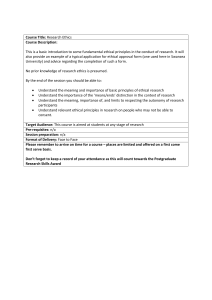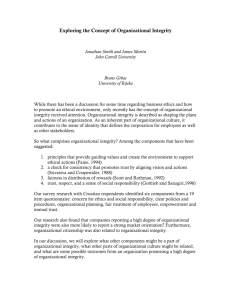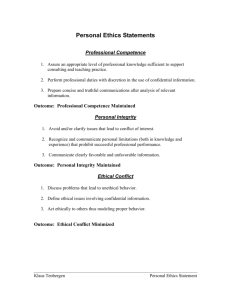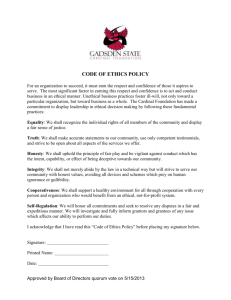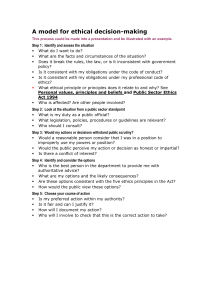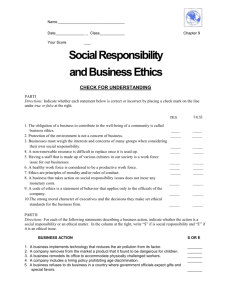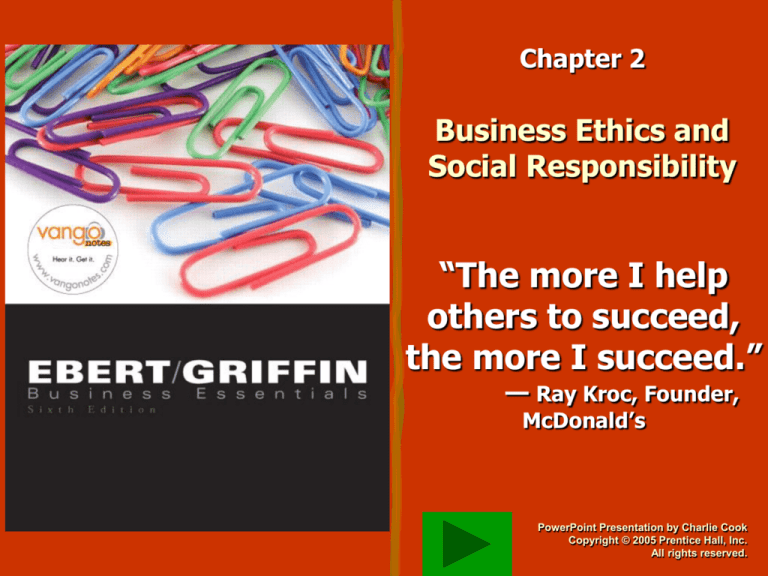
Chapter 2
Business Ethics and
Social Responsibility
“The more I help
others to succeed,
the more I succeed.”
— Ray Kroc, Founder,
McDonald’s
PowerPoint Presentation by Charlie Cook
Copyright © 2005 Prentice Hall, Inc.
All rights reserved.
Business 24: Business Issues and Ethics
• 3 unit semester length class
• Ethics in American business
• Environmental pollution
• Insider trading
• Sexual harassment
• Responsibility to all parties affected by decisions
Copyright © 2005 Prentice Hall, Inc. All rights reserved.
2–2
How do you measure success?
In 1923, a very important meeting was held at the Edgewater Beach Hotel in Chicago.
Attending this meeting were nine of the richest men in the world: (1) Charles Schwab,
President of the world's largest independent steel company; (2) Samuel Insull, President
of the world's largest utility company; (3) Howard Hopson, President of the largest gas
firm; (4) Arthur Cutten, the greatest wheat speculator; (5) Richard Whitney, President of
the New York Stock Exchange; (6) Albert Fall, member of the President's Cabinet; (7)
Leon Frazier, President of the Bank of International Settlements; (8) Jessie Livermore,
the greatest speculator in the Stock Market; and (9) Ivar Kreuger, head of the company
with the most widely distributed securities in the world.
Twenty-five years later, (1) Charles Schwab had died in bankruptcy, having lived on
borrowed money for five years before his death. (2) Samuel Insull had died virtually
penniless after spending some time as a fugitive from justice. (3) Howard Hopson was
insane. (4) Arthur Cutten died overseas, broke. (5) Richard Whitney had spent time in
Sing-Sing. (6) Albert Fall had been pardoned from prison so he could die at home. (7)
Leon Fraizer, (8) Jessie Livermore, and (9) Ivar Kreuger each died by suicide.
Measured by wealth and power these men achieved success, at least temporarily.
Making a lot of money may be an acceptable goal, but money most assuredly does not
guarantee a truly successful life. How do you measure success?
Copyright © 2005 Prentice Hall, Inc. All rights reserved.
2–3
Note: This article is from Chapter 9 of the authors' book: Accounting Information Systems, 3rd Edition, Cincinnati, Ohio: Thomson Learning - Dame
Division, 2002, ISBN: 0-324-10920-2. See http://www.snopes.com/glurge/fortune.asp for a more neutral discussion of this folklore topic.
Key Topics
• Ethics and Individual codes of ethics
• Ethics in the workplace
• Social Responsibility
Copyright © 2005 Prentice Hall, Inc. All rights reserved.
2–4
What Is Ethical Behavior?
Ebert says….
• Ethics
Right and wrong, good
and bad, in actions that
affect others
• Ethical Behavior
Conforming to
generally accepted
ethical norms
• Ethical nihilism
The denial of the existence
of any possible basis for the
establishment of an ethical
or moral philosophy.
Copyright © 2005 Prentice Hall, Inc. All rights reserved.
2–5
What Is Ethical Behavior?
Webster says….
• Ethics: The body of moral
principles or values of a
culture, or group, or
individual.
• Who’s ethics to follow?
The law vs. ethics?
International business?
My ethics?
Copyright © 2005 Prentice Hall, Inc. All rights reserved.
2–6
Individual Code of Ethics
Determining Factors
• Core Values
Religion/Philosophy/
Goals
• Background
• Dependency
What are your options?
• Personality
Functional sociopath
• Responsibility of
consequence
Copyright © 2005 Prentice Hall, Inc. All rights reserved.
2–7
Assessing Ethical Behavior
• Consider these four ethical norms…
Utility: Does it optimize what is best for those who
are affected by it?
Rights: Does it respect the rights of the individuals
involved?
Justice: Is it consistent with what we regard as fair?
Caring: Is it consistent with people’s responsibilities
to each other?
Copyright © 2005 Prentice Hall, Inc. All rights reserved.
2–8
Steps in Making Ethical Judgments
What options are there,
look hard!!!
Who is involved?
How are they affected?
Utility maximizing?
Rights respecting?
Just and fair?
Is it responsible? Caring?
Select the most important
criterion for the decision.
Select the best option
based on the most
important criterion.
Copyright © 2005 Prentice Hall, Inc. All rights reserved.
Figure 2–1
2–10
Expanded Model of Ethical Judgment Making
Data
Gathering
Get the information you need to judge
Is the act or policy acceptable according to the four ethical norms?
• Utility: Does it optimize the satisfaction of all parties?
• Rights: Are rights and duties of the individuals involved respected?
• Justice: Is it fair & legal (would you want mom to know about it)?
Analysis
• Caring: Is it consistent with the responsibility to care?
No on one or
two criteria
No on all
criteria
Yes on all
criteria
Good reason to override?
Is one norm more important than the others?
Judgment
Is there a reason such as a law or valid policy that
forces a person into an action?
No
The act or policy is not ethical.
Copyright © 2005 Prentice Hall, Inc. All rights reserved.
Yes
The act or policy is ethical.2–11
Figure 2–2
Example: Measuring Costs of Ethics
• We will make a “sure thing” $2.5 billion profit if
we don’t reveal a nearly undetectable problem.
• There is virtually “no chance” we will get caught
concealing the problem.
• It seems plausible to assign the values of:
Don’t tell: get $2.5 billion
Tell: lose $2.5 billion, and derail your career path
Copyright © 2005 Prentice Hall, Inc. All rights reserved.
2–12
Example: Measuring Costs of Ethics
• Vioxx brought in $2.5 billion in annual sales
• The first case tried received a $253 million judgment.
• A.P. estimates between 50,000 – 160,000 US heart
problems may be Vioxx’s responsibility.
• What else was wrong with this sort of probability
analysis as a basis to ethical decision making?
• Which is more expensive?
The lost trust or
the potential legal judgment?
Copyright © 2005 Prentice Hall, Inc. All rights reserved.
2–13
Example: Measuring Costs of Ethics
• Research indicates about
twice the heart attack risk in
certain long-term Vioxx users.
• “…we were going to make a
decision about Vioxx totally in
the interest of patient safety."
– Ray Gilmartin CEO Merck
Copyright © 2005 Prentice Hall, Inc. All rights reserved.
2–14
What Merck’s culture may have learned
if the Vioxx issues weren’t revealed:
• It is good enough to “appear responsible”.
• The patient focus is really secondary to profits
• If we won’t get caught, there is no ethical breach
• Do I trust the company to treat me fairly?
• Do I need to treat the company fairly?
• Do I want to be associated with Merck?
Copyright © 2005 Prentice Hall, Inc. All rights reserved.
2–15
Business Ethics
• Typical targets of ethical consideration:
Behavior toward employees
Behavior toward the business
Behavior toward other stakeholders
• Creating a right answer when none exists
Copyright © 2005 Prentice Hall, Inc. All rights reserved.
2–17
Factors That Cause unethical workplace
behavior
• Pressure to meet sales, budget or
profit goals
Who’s in trouble: The boss or the
worker?
• Personal financial worries
Low personal options
• Poor communication
What does “Do what it takes” mean?
• Lack of ethical commitment
Personal or organizational
Doing
unto others as they do
unto you
Copyright © 2005 Prentice Hall, Inc. All rights reserved.
2–18
Establishing a Social Responsibility Program
Copyright © 2005 Prentice Hall, Inc. All rights reserved.
Figure 2–7
2–19
Checking the ethics of an organization
•
•
•
•
•
•
Does the mission include ethical values?
A written code of ethics (SOX)
Top management following the code
Ethics office
Procedures to address ethical concerns
A tradition of enforcement & justice
Even within the informal culture of the firm
• Question: When is the right time for you to
check this out? How do you really know?
Copyright © 2005 Prentice Hall, Inc. All rights reserved.
2–20
Organizational Ethics Determining
Factors
• Top Level Management driving philosophy
Actions
speak louder than words.
• The firm’s reward system
• True culture
• Example: If your CEO encourages you to
cheat vendors, how do you expect you are
being treated? How do you think you will
treat the organization?
Copyright © 2005 Prentice Hall, Inc. All rights reserved.
2–21
What’s left?
• Social Responsibility
• Ethical dilemma group discussions
Applying an ethical decision making process
Copyright © 2005 Prentice Hall, Inc. All rights reserved.
2–22
Social
Responsibility:
Balancing
Commitments to
Stakeholders
Employees
Investors
Community
Copyright © 2005 Prentice Hall, Inc. All rights reserved.
Suppliers
Customers
Figure 2–4
2–23
Spectrum of Social Responsibility
Obstructionist
Stance
Do whatever you can
get away with
* Top 100 List
Meet minimum legal
standards with a sole
focus on profits
*Milton Friedman
Defensive
Stance
Respond to requests and
focus on cost/benefit of
S.R.: “Looks proactive”….
*What do you think?
Accommodative
Stance
Actively seek S.R.
opportunities. Woven into
the company culture
Copyright © 2005 Prentice Hall, Inc. All*Boston
rights reserved.
College List
Proactive
Stance
2–24
Mini-Case: BP Oil
• What do you think about BP’s ethical culture?
BP’s message
• Recent BP oops a daisy
Oil Pipeline bursting
• Now what do you think?
Is BP’s S.R. stance Accommodative or Proactive?
Copyright © 2005 Prentice Hall, Inc. All rights reserved.
2–25
The evolution of social responsibility
• “The invisible hand” of self
interest maximizes wealth
and standard of living.
• Abuses of power bring
regulation.
• “Add-on” social
consciousness efforts as
marketing image builders
• Social consciousness
interwoven in the fabric of
the company culture
Top 100 corporate citizens
Copyright © 2005 Prentice Hall, Inc. All rights reserved.
2–26
Do the following statements make sense:
• Times are hard, therefore it is in my interest to pollute more and run an
increased risk of prosecutions and fines, not to mention attracting the
attention of environmental pressure groups
• Times are hard, therefore I can afford to lose some of my most talented
people - serving or potential - by erecting barriers on the basis of race,
gender, age or sexual orientation. And it doesn't matter if employment
tribunals occur as a result of my poor employment practices.
• Times are hard, therefore I need to ignore changing values in my customer
base towards socially responsible goods and services. I can keep making
things just the way I always have.
• Times are hard, so I can ignore the fact that the local communities around
my plant are poor living environments with low education achievement,
meaning that my best staff won't want to live in them and our future staff will
need supplementary training in basic skills such as literacy which they
should be getting at school. Our company can be an island of prosperity in a
sea of deprivation
Copyright © 2005 Prentice Hall, Inc. All rights reserved.
2–27
From http://www.mallenbaker.net/csr/CSRfiles/against.html
Goals of Business:
From business perspective
Survival
Growth
Copyright © 2005 Prentice Hall, Inc. All rights reserved.
Profit
Social
Responsibility
2–28
Ethical Dilemma Cases
• Make sure you address these points:
What parties are effected by your decision?
How are the four ethical norms involved?
Utility,
rights, justice, caring
• Work through the process and make a decision
Show evidence of working through the process in
your written assignment.
• You have 10 minutes to prepare your individual
Analysis. Then we form teams and your
partners will see the quality of your work.
Copyright © 2005 Prentice Hall, Inc. All rights reserved.
2–32
Ethical Dilemma case discussions:
Case discussion: Ethical Dilemmas
How
do we run case studies?
Group by topic this time.
Pick
a leader.
The group case write-ups are due before lecture
starts next week.
Please finish these well ahead of time to allow for the
chapter 3 homework that is also due that day.
Individuals:
Do you need to follow up with anyone?
Remember your grade depends on it.
Copyright © 2005 Prentice Hall, Inc. All rights reserved.
2–33
Ethical Dilemma Case Leaders:
• Case Discussion Leader Responsibilities and
Rating Form
Leader role
Participant role
The final product – what to turn in
Group participation rating form
Copyright © 2005 Prentice Hall, Inc. All rights reserved.
2–35
Expanded Model of Ethical Judgment Making (p 42)
Data
Gathering
Get the information you need to judge
Is the act or policy acceptable according to the four ethical norms?
• Utility: Does it optimize the satisfaction of all parties?
• Rights: Are rights and duties of the individuals involved respected?
• Justice: Is it fair & legal (would you want mom to know about it)?
Analysis
• Caring: Is it consistent with the responsibility to care?
No on one or
two criteria
No on all
criteria
Yes on all
criteria
Good reason to override?
Is one norm more important than the others?
Judgment
Is there any reason why a person is being forced
into committing an act or following a policy?
No
The act or policy is not ethical.
Copyright © 2005 Prentice Hall, Inc. All rights reserved.
Yes
The act or policy is ethical.2–36
Figure 2–2
Expanded Model of Ethical Judgment Making (p 42)
Data
Gathering
Get the information you need to judge
Is the act or policy acceptable according to the four ethical norms?
• Utility: Does it optimize the satisfaction of all parties?
• Rights: Are rights and duties of the individuals involved respected?
• Justice: Is it fair & legal (would you want mom to know about it)?
Analysis
• Caring: Is it consistent with the responsibility to care?
No on one or
two criteria
No on all
criteria
Yes on all
criteria
Good reason to override?
Is one norm more important than the others?
Judgment
Is there any reason why a person is being forced
into committing an act or following a policy?
No
The act or policy is not ethical.
Copyright © 2005 Prentice Hall, Inc. All rights reserved.
Yes
The act or policy is ethical.2–41
Figure 2–2
Corporate Annual Giving
Merck
Johnson & Johnson
Pfizer
Eli Lilly
IBM
Microsoft
Intel
Bank of America
Source: The Taft Group
Copyright © 2005 Prentice Hall, Inc. All rights reserved.
$221.0*
176.2
123.9
121.4
116.1
104.7
101.0
91.5
* In Millions
2–62


